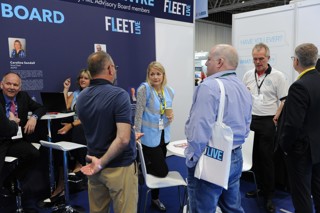
Even the best ideas may not be adopted if not properly researched and presented, but there are steps you can take to enhance their chances of success. Andrew Ryan reports
Gaining boardroom buy-in is essential to the success of any new fleet initiative: if it isn’t backed by directors, then even a ground-breaking idea will not be introduced.
In addition, differing company cultures and management structures mean there is no guaranteed way to achieve approval. For example, some fleet managers may report directly to the board or a board member.
A growing number of companies take a different approach. They have introduced fleet steering committees, which comprise board members and other key stakeholders.
These board members are given a remit by the executive management board when empower them to make decisions on behalf of the company.
Siemens has adopted this approach. Paul Tate, commodity manager at Siemens says: “That allows us to streamline a lot of decisions in relation to fleet, so it makes sure that there is not a lot of debating over the same subject.
“You usually find that having a smaller audience allows discussion to take place with the result that we get to the right decisions sooner rather than later.”
However, while management structures may vary, there are key lessons which can be applied to the vast majority of businesses.
1. Understand your audience
Simon Boggis, chief procurement officer for Ceva Logistics, believes it is vital for fleet decision-makers to know their audience. “Know what is driving your company and what your CEO is looking for,” he says.
“Many of those areas will be shared by different companies such as the cost of investment, the return on investment and what the risks are, but each individual business will have different priorities.
“For example, my company is owned by private equity. Cash is absolutely king for us, but a blue-chip, cash-rich pharmaceutical company may have a different driver.
“When you are developing proposals and you want to influence change, it’s about understanding what your employer’s goals and objectives are.”
Members of Siemens’s fleet steering committee have access to a locked social network where they can see proposals before the date of a board meeting, as well as provide feedback and ask questions.
“We can use this feedback to gain an insight into what they’re looking for, so we can understand what makes them tick and play to those strengths,” says Tate.
He adds that, while cost is obviously is an important consideration for a business, it is not the only factor a board looks at.
“The subject of the proposal determines where the board’s focus is,” says Tate.
“It could be cost, driver welfare or driver pain in relation to ‘is that not putting complexity in? Will the driver like that?’
“Some parts of our fleet policy are an employee benefit and if we put forward a proposal affecting something we use as an incentive for employee retention, the board may ask if we are diluting that benefit.”
2. Consult with other departments
The views of all key stakeholders should be obtained prior to the presentation of any proposal, says Geoffrey Bray, chairman of the Fleet Industry Advisory Group.
“Ultimately, their views will become the cornerstone of the subsequent tendering process and any contract that will define the long-term efficiency and effectiveness of the fleet operation,” he says.
“Depending on the size of the organisation, this could include input from departments such as procurement, finance, HR, legal, health and safety and environment.
“Such an approach ensures the proposal process is both well run and has a clearly defined and auditable objective.”
Siemens uses its locked social network to allow its fleet steering committee to access information about a proposal.
“We found that giving the steering group access to what we are going to present allows its members to look at it, digest it and raise questions, so when we go into the meeting it is down to business; it is slick and keeps the conversation flowing,” says Tate.
Boggis says fleet managers need to take a holistic view when putting together a proposal.
“In procurement, you can’t say ‘I can’t get on with finance’ – you need to get on with finance, it is the key to everything in a company,” he says.
“You need to demonstrate that you don’t want to, for example, run finance or IT – but you all bring different skills to the table.
“You also need to remember that your priorities may not always be your colleagues’ priorities.
“The guy running the operations delivering the service to the customer may be looking at customer satisfaction, while we in procurement are looking at cost efficiency and the supply chain.
“This means that at you need to understand at the very start of it what you are trying to achieve, what the board’s goals and objectives are, and align your thinking as to how you can help deliver on those company goals. Then you can become an influencer: you are part of the solution, not part of the problem.”
3. Keep the proposal simple
“The key thing is not to baffle people with science when presenting a proposal: keep it simple,” says Tate.
“The board members may not be fleet experts, so you will need to put the proposal in a format which is easy to understand.
“It should be factual, it shouldn’t leave any area open which can be challenged, and you should go fully armed for any potential question.”
Tate sometimes sends his presentations to his director with responsibility for the supply chain ahead of a board meeting for him to look at.
“He speaks to the board more than I do, so he may want to add additional questions,” he adds.
“You have to prepare in minute detail because if you lose credibility with that audience it is very difficult to get back.
“A lot of it is about building trust. At times, things may not go 100% the way you want them to, but you should carry out a full risk analysis and show them the risks of that particular proposal.
“This way, if things don’t work out how you want them to, the board can say ‘well, we did know the risks but there have been a lot more positives than negatives with this initiative’.”
David Oliver, procurement manager at Red Bull, who is responsible for running his company’s fleet, says his approach is to be transparent and to give board members the essential information they need to enable them to make a decision.
“If they want to ask more questions or to find out more, they know that we will have the answers,” he says.
“In the past we’ve almost overblown it to show our knowledge and expertise, and the board has said ‘just give us the top line and we’ll ask if it doesn’t make sense’.”
4. Keep the board informed of the project's progress
Developing trust between the board and the fleet operation is vital to gaining backing for future initiatives, so it is important that they are kept up-to-date with the progress of initiatives that have been introduced.
“I think the worst thing you can do is put something together that looks brilliant on paper and then the board doesn’t hear about it again,” says Oliver.
“They can either assume it’s gone well and the fleet manager hasn’t blown their own trumpet, or it’s gone very badly and they’re trying to keep it quiet.”




















Login to comment
Comments
No comments have been made yet.